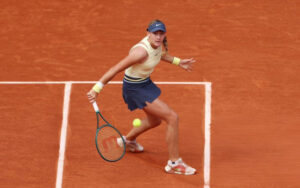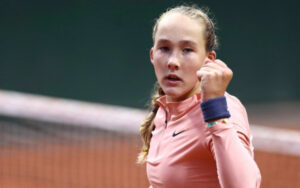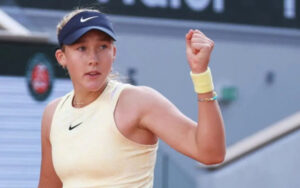
Like a whiff of fresh air, Mirra Andreeva, just 17, showed there is a champion streak in her as well. At the Court Philippe-Chatrier, on Wednesday evening, the Russian came out firing from the trenches as she outslugged second seed Aryna Sabalenka 6-7 (5/7), 6-4, 6-4 in two hours and 29 minutes to enter the semi-finals of the French Open.
Teen prodigy, callow youth, what does one make of Mirra, the Russian who showed what it means to compete at a very high intensity on the big stage. Nobody wins matches against Sabalenka easily. The defending Australian Open champion is tough, in every sense. She hails from Belarus and has been plying her trade for a much longer time.
It’s not just the age comparison which is stark. Miira is from Russia and represents what a teen sensation can do, channelising inner energy and ensuring she can implement her stroke production against even seasoned pros. For those who watched Mirra come out smoking against Sabalenka, it was a throwback to the old days of many Russians and even American teenagers who would play bold and beautiful tennis.
After having been adjudged the most promising rising star in 2023 by the WTA (Women’s Tennis Association), Mirra has changed gears swiftly. Last year, at the hallowed precincts of Roland Garros, where tennis is consumed by the nouveau riche as well as the passionate fans, Mirra showed glimpses of her potential. After all, the transition from playing in Grand Slam junior events to shifting gears and playing the ladies event is not easy. She had shown in 2023, at the French Open, she could raise her game. So, a third round-entry was more than promising before she lost to Coco Gauff, a year back.
Then again, for someone who is still learning the tricks of the trade from Conchita Martinez, Mirra is a fast learner. For those who followed women’s tennis in the 90s, Conchita defined what it is to be a Spanish player. For that generation, the baseline game was bread and butter. Yet, Conchita had shown even with that game she could win Wimbledon in 1994. No mean feat that, since in that era, grass was slick, bounce was low and nothing like long rallies. In addition, Conchita was also runner-up at the Australian Open in 1998 and French Open in 2000.
For the Latest Sports News: Click Here

Why is the background of a tennis coach important? It is well known, tennis stars choose coaches based on what value they can bring. Mirra was born in Krasnoyarsk, Russia, but has based herself in Cannes, France. That she has been a precocious bundle of talent is well known. To drill her further into becoming a potential champion has been a journey where Conchita has worked with the kid.
First things first, what stood out in Mirra’s game was not being one-dimensional. Everyone knows, Aryna Sabalenka, a Belarussian, has faced massive criticism in the last two years because of the country she hails from. It is not her fault in the ongoing war between Russia and Ukraine, since 2022, Belarus has offered more than just tacit help to Prez Vladimir Putin’s defence forces.
Players have often expressed their views on social media and at tennis press conferences. They have nothing to do with war but aren’t spared from the hatred by fans and media. Sabalenka has spent a lot of time in doing so, since the Australian Open was known for its notoriety in 2023.
On court, on Wednesday, Aryna was waging a battle, not war, against a kid who came up with stuff which was sublime. One would imagine, on the red clay in Paris, which has come in for copious criticism from players and public, underfoot conditions are not easy. After all, for Novak Djokovic to go under the scalpel in the Capital of France for a torn meniscus in his knee on Wednesday is a grim reminder of how elements and humans led to him getting injured so badly.

Luckily, Mirra and Aryan played in better conditions, though, to be on court for almost 150 minutes is a sign, there was a massive slugfest. For those who have watched tennis from the Martina Navratilova and Christ Evert era, tennis, then, was softer and more skillful. No, these days it is about being bold and beautiful. The execution of shots is more potent, the power they generate is higher and while serving, the tennis bell is belted from a high arch with no mercy.
Indeed, four aces, rifling in serves at 185kmph and making sorties to the net as well, defined the way Mirra was handling champion Aryna. It needed pedigree as well as the mindset to execute the plan. Yes, when a player “goes for broke,” to borrow a tennis phrase, errors will also creep in – forced and unforced. But then, Mirra was not going to stop. The groundstroke exchanges between the Russian and Belarussian was heavy artillery, a reminder of how that poor, fuzzy tennis ball was created to be ripped by those high-tension racquet strings. A rough comparison, the 261 groundstrokes from Mirra was superior to Aryna’s efforts because she was playing minus nerves. If the drop shot, such an effective weapon, can work even on clay, then Mirra produced 12 of them, to change the pace in rallies.
“I really tried to focus. And when it was match point, I tried to imagine I was saving a break point,” said Mirra later. The girl did not forget to thank her coach Conchita. “Me and my coach had a plan today, but I don’t remember anything!” said the kid, later at the press conference.
Women’s tennis has been witnessing a massive spurt in terms of growth. For every Iga Swiatek out there, plus Sabalenka and Elena Rybakina, the arrival of kids like Mirra is a reminder, more intense contests will be seen on the tennis courts.
For the record, Mirra is the youngest Grand Slam semi-finalist since Martina Hingis, at 16, during the US Open in 1997. Swiss Hingis was also the youngest French Open semi-finalist, the same year at Roland Garros.
Also Read: “What more could I have wanted as a player?” – Sunil Chhetri opens up on his last bow